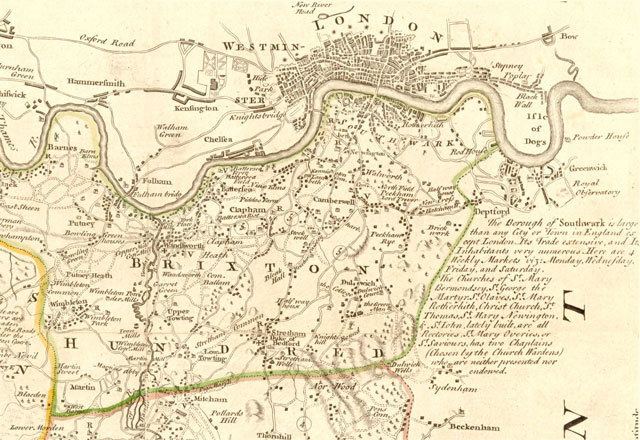Status Hundred | ||
 | ||
Brixton Hundred or the Hundred of Brixton was an ancient hundred in the north east of the county of Surrey, England. Its area has been entirely absorbed by the growth of London; with its name currently referring to the Brixton district. Its former area now corresponds to the London Borough of Southwark, the London Borough of Lambeth, the London Borough of Wandsworth and parts of the London Borough of Merton and the London Borough of Richmond upon Thames.
Contents
History
The name is first recorded as Brixiges stan in 1062, meaning stone of a man called Beorhtsige. The stone may have been the location that early hundred meetings took place. Gower suggests that the stone was located at the boundary of Streatham, Clapham and Lambeth parishes. A nearby location on Brixton Hill became the location for the hundred gallows. Brixton Hill had been known as Bristowe Causeway long before the modern Brixton area was developed. The Surrey House of Correction, now known as Brixton Prison, was opened there in 1820.
The hundred contained the parishes of Battersea (including the detached part of Penge), Bermondsey (also later Rotherhithe), Camberwell, Hatcham, Lambeth, Walworth, Streatham, Barnes, Merton, Mortlake (also later Wimbledon and Putney), Tooting and Wandsworth.
The northern boundary with the City of London and the Ossulstone hundred of Middlesex was the River Thames. Within Surrey it was bounded by Wallington hundred to the south and Kingston hundred to the west. In the east was a boundary with the Blackheath hundred of Kent.
In 1831, the hundred occupied 30,400 acres (123 km2). Most of the hundred (except Barnes, Merton, Mortlake and Wimbledon) was included in 1829 in the Metropolitan Police District by the Metropolitan Police Act 1829 and in 1840 the rest of the hundred was included by the Metropolitan Police Act 1839.
In 1851 the hundred is recorded as comprising an Eastern division (including Lambeth) of 22,186 acres (90 km2) and a population of 314,815 and Western division (including Wandsworth) of 7,699 acres (31 km2) and a population of 9,552. The population in 1861 is recorded as 409,504. In 1887 the hundred is recorded as occupying an area of 29,714 acres (120 km2), with a population of 825,155.
Replacement
The hundreds of England declined in administrative use because of the rise of various ad hoc boards. In 1855, most of the hundred (except Barnes, Merton, Mortlake and Wimbledon) was included in the area of responsibility of the Metropolitan Board of Works by the Metropolis Management Act 1855. The hundred was effectively abolished when the area (except Barnes, Merton, Mortlake and Wimbledon) became part of the County of London in 1889. The entire area has formed part of Greater London since 1965.
In 1894 and 1900 all local government functions were effectively replaced by a system of uniform districts, which were consolidated over time and finally replaced in 1965 by the London boroughs which are still in use today.
